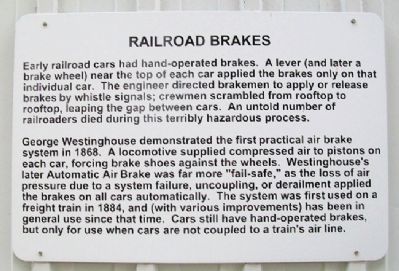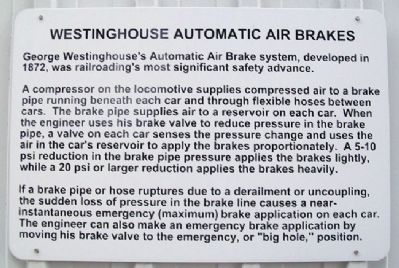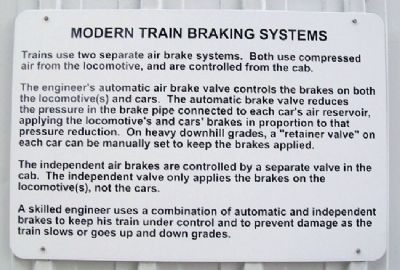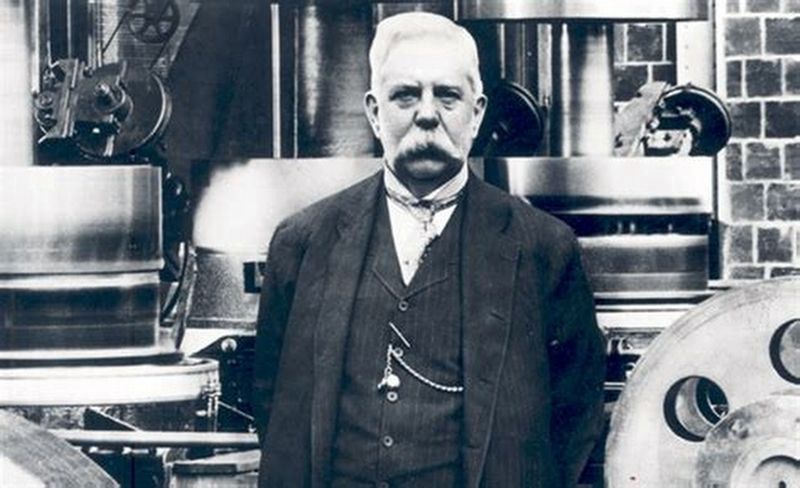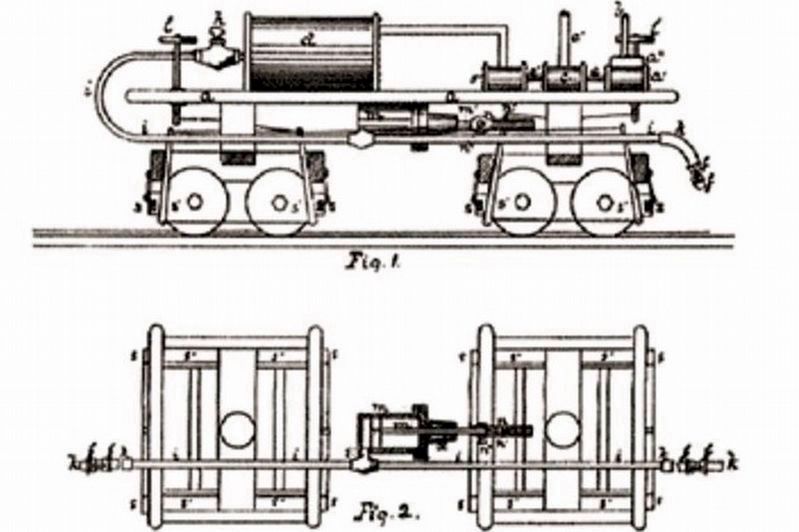Near Union in McHenry County, Illinois — The American Midwest (Great Lakes)
Railroad Brakes / Westinghouse Automatic Air Brakes
Railroad Brakes
Early railroad cars had hand-operated brakes. A lever (and later a brake wheel) near the top of each car applied the brakes only on that individual car. The engineer directed brakemen to apply or release brakes by whistle signals; crewmen scrambled from rooftop to rooftop, leaping the gap between cars. An untold number of railroaders died during this terribly hazardous process.
George Westinghouse demonstrated the first practical air brake system in 1868. A locomotive supplied compressed air to pistons on each car, forcing brake shoes against the wheels. Westinghouse's later Automatic Air Brake was far more "fail-safe," as the loss of air pressure due to a system failure, uncoupling, or derailment applied the brakes on all cars automatically. The system was first used on a freight train in 1884, and (with various improvements) has been in general use since that time. Cars still have hand-operated brakes, but only for use when cars are not coupled to a train's air line.
——————
Westinghouse Automatic Air Brakes
George Westinghouse's Automatic Air Brake system, developed in 1872, was railroading's most significant safety advance.
A compressor on the locomotive supplies compressed air to a brake pipe running beneath each car and through flexible hoses between cars. The brake pipe supplies air to a reservoir on each car. When the engineer uses his brake valve to reduce pressure in the brake pipe, a valve on each car senses the pressure change and uses the air in the car's reservoir to apply the brakes proportionately. A 5-10 psi reduction in the brake pipe pressure applies the brakes lightly, while a 20 psi or larger reduction applies the brakes heavily.
If a brake pipe or hose ruptures due to a derailment or uncoupling, the sudden loss of pressure in the brake line causes a near-instantaneous emergency (maximum) brake application on each car. The engineer can also make an emergency brake application by moving his brake valve to the emergency, or "big hole," position.
——————
Modern Train Braking Systems
Trains use two separate air brake systems. Both use compressed air from the locomotive, and are controlled from the cab.
The engineer's automatic air brake valve controls the brakes on both the locomotive(s) and cars. The automatic brake valve reduces the pressure in the brake pipe connected to each car's air reservoir, applying the locomotive's and cars' brakes in proportion to that pressure reduction. On heavy downhill grades, a "retainer valve" on each car can be manually set to keep the brakes applied.
The independent air brakes are controlled by a separate valve in the cab. The independent valve only applies the brakes on the locomotive(s), not the cars.
A skilled engineer uses a combination of automatic and independent brakes to keep his train under control and to prevent damage as the train slows or goes up and down grades.
Erected by Illinois Railway Museum.
Topics. This historical marker is listed in this topic list: Railroads & Streetcars. A significant historical year for this entry is 1868.
Location. 42° 13.723′ N, 88° 31.626′ W. Marker is near Union, Illinois, in McHenry County. Marker is on the north wall of Barn 3, on the grounds of the Illinois Railway Museum. Marker is at or near this postal address:. Touch for map. Marker is at or near this postal address: 7000 Olson Road, Union IL 60180, United States of America. Touch for directions.
Other nearby markers. At least 8 other markers are within walking distance of this marker. Couplers (here, next to this marker); Simplex Type Automatic Coupler (here, next to this marker); Railroad Standard Time (a few steps from this marker); Railroad Rails (a few steps from this marker); Chicago Railways Company Date Stone (within shouting distance of this marker); Indiana Harbor Belt 1181 (within shouting distance of this marker); Early Railroad Signals (within shouting distance of this marker); 1851 Marengo Station (within shouting distance of this marker). Touch for a list and map of all markers in Union.
Also see . . .
1. George Westinghouse. Wikipedia biography. (Submitted on October 26, 2020, by Larry Gertner of New York, New York.)
2. Westinghouse Air Brake Company. Wikipedia entry. (Submitted on October 26, 2020, by Larry Gertner of New York, New York.)
3. Westinghouse Patents and Inventions. (Submitted on December 19, 2010, by William Fischer, Jr. of Scranton, Pennsylvania.)
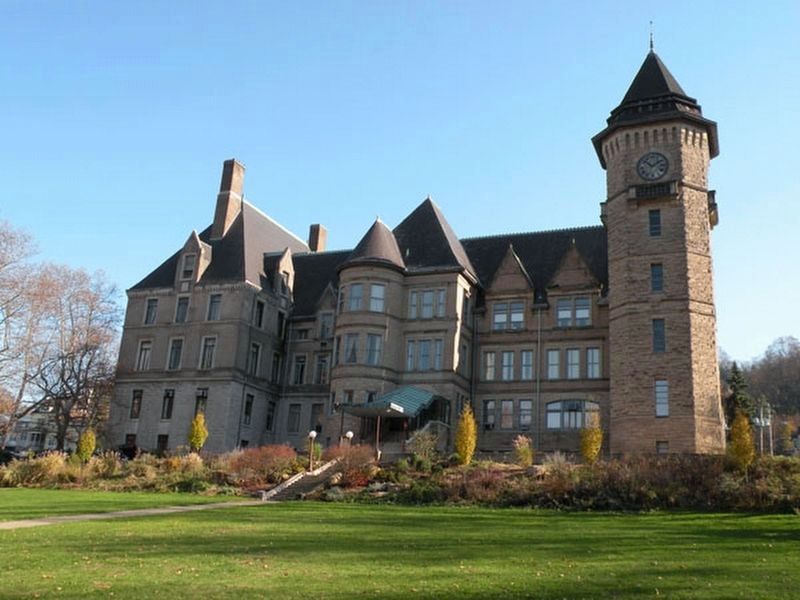
Photographed By Lee paxton/Wikipedia, 2009
6. The Westinghouse Air Brake Company General Office Building
Located at Marguerite and Bluff Streets in Wilmerding, Pennsylvania. This building contained the offices of the Westinghouse Air Brake Company, founded by George Westinghouse. The building is listed on the National Register of Historic Places.
Architect: Frederick J. Osterling (1890), with additional designs and remodeling done by Janssen & Cocken in 1927. Architectural style: Renaissance Revival, Other, Romanesque Revival.
Architect: Frederick J. Osterling (1890), with additional designs and remodeling done by Janssen & Cocken in 1927. Architectural style: Renaissance Revival, Other, Romanesque Revival.
Credits. This page was last revised on October 26, 2020. It was originally submitted on December 19, 2010, by William Fischer, Jr. of Scranton, Pennsylvania. This page has been viewed 2,494 times since then and 97 times this year. Photos: 1, 2, 3. submitted on December 19, 2010, by William Fischer, Jr. of Scranton, Pennsylvania. 4, 5, 6. submitted on October 26, 2020, by Larry Gertner of New York, New York.
